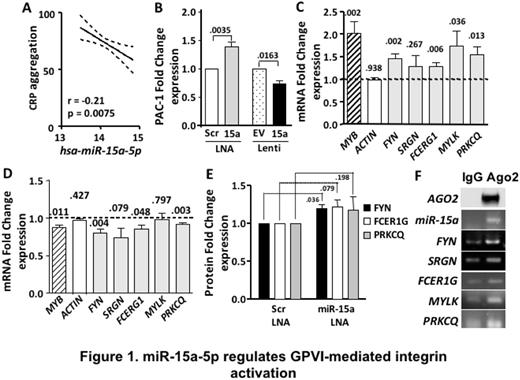Abstract
Introduction: Platelet activation by collagen is a major effector ofnormal hemostasis. Mutations in GPVI, the major collagen signaling receptor, cause platelet-type bleeding. Two single nucleotide polymorphisms in GPVI have been identified as risk factors for myocardial infarction. Elevated levels of GPVI have been reported in patients with coronary syndromes. GPVI and its signaling pathway components for platelet activation have become potential antithrombotic targets. Reports have indicated microRNAs (miRs) regulate platelet activation, but none have considered the mechanisms involving miR-mRNA associations regulating the GPVI-mediated platelet activation pathway.
Aims: To identify and characterize miRs regulating GPVI-mediated megakaryocyte (MK) integrin activation.
Methods : Candidate miRs were identified via a platelet function association study. miR function was assessed by knockdown or overexpression studies in MKs derived from umbilical cord blood (CB) CD34+ stem cells. MK αIIbβ3 activation was measured by flow cytometric quantification of PAC-1 binding after collagen-related peptide (CRP) stimulation. miR and mRNA quantification were performed using quantitative polymerase chain reaction.
Results: Our P latelet R NA A nd e X pression (PRAX1) study identified 20 miRs associated with CRP-induced platelet aggregation (p<0.008; n=154). To minimize false positives, we considered only miRs expressed in both platelets and cultured MKs, reducing the potential candidates to 10. We focused on miR-15a-5p because it is negatively correlated with platelet activation through CRP (p=0.0075) (Fig 1A) and because miR-15a-5p targets BCL2, which is known to enhance CRP-induced platelet activation. miR-15a-5p was not found to be associated with platelet aggregation in response to arachidonic acid, ADP, PAR1-AP or PAR4-AP, suggesting specificity of miR-15a-5p for GPVI-mediated integrin activation pathway. Knock down of miR-15a-5p using locked nucleic acid (LNA) in CBMKs caused a ~38% increase in CRP-induced integrin-activation (p=0.0035; n=7) compared to the scrambled (Scr) LNA control (Fig 1B), presumably by releasing miR-15a-5p repression of activation. Fig 1B shows lentiviral overexpression of miR-15a-5p decreased CRP-induced integrin-activation by ~33% (p=0.0154; n=4) as compared to empty vector (EV) control. To understand how miR-15a-5p regulates integrin activation, we bioinformatically identified putative mRNA targets FYN, SRGN, FCER1G, MYLK and PRKCQ, predicted to be regulated by miR-15a- 5p and known as signaling molecules in the GPVI activation pathway. Of note, GPVI was not predicted to be a target of miR-15a-5p and BCL2 was not included because it has been studied before. Importantly, these target genes are positively associated with CRP-induced platelet aggregation (all p<0.004; n=154). The transcript levels of FYN, FCER1G, MYLK and PRKCQ were derepressed upon miR-15a-5p knockdown (Fig 1C) as compared to Scr LNA (all p<0.05; n>4). In miR-15a-5p overexpressed CBMKs, transcript levels of FYN, FCER1G and PRKCQ were decreased compared to EV (Fig 1D) (all p<0.05; n=4). SRGN only showed trends upon miR-15a-5p manipulation. MYB and ACTIN were used as positive and negative controls, respectively. Initial studies of miR-15a-5p knockdown showed a trend for increased FYN, FCER1G and PRKCQ protein levels (Fig 1E; n=3). miR activity requires binding to Argonaute2 (Ago2), which catalyzes translational repression and mRNA degradation. We demonstrated that Ago2 immunoprecipitation enriches miR-15a-5p and its target FYN, SRGN, FCER1G, MYLK and PRKCQ mRNAs (Fig 1F). These data suggest miR-15a-5p and its targets are processed through the Ago complex and thereby, are potential miR-mRNA pairs together regulating GPVI-mediated integrin activation pathway.
Conclusions: miR-15a-5p negatively regulates GPVI-mediated MK integrin activation. miR-15a-5p appears to act as a 'master-miR' regulating multiple components of GPVI-mediated platelet and MK activation. As miRs are increasingly becoming clinical therapeutic targets, miR-15a-5p overexpression shows potential for treating thrombosis, whereas its inhibition could be effective in bleeding disorders.
No relevant conflicts of interest to declare.
Author notes
Asterisk with author names denotes non-ASH members.


